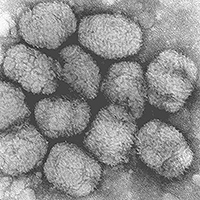Jonathan Tucker
Ray Zilinskas
June 19, 2002

Smallpox Virus,
Source: Wikimedia Commons
View the full Release of a Secret Soviet Smallpox Report Occasional Paper:
Authoritative English Translation by:
- The Center of Nonproliferation Studies at The Monterey Institute of International Studies
The Center released today the translation of an official Soviet report describing a previously unknown outbreak of smallpox in 1971 in the city of Aralsk, Kazakhstan, then located on the northern shore of the Aral Sea. A retrospective analysis suggests that the outbreak may have originated in an open-air test of a smallpox biological weapon on Vozrozhdeniye Island, a top-secret Soviet biowarfare testing ground in the middle of the sea. If the analysis is correct, it provides the first evidence that the Soviet Union field-tested a smallpox weapon and that such testing caused civilian deaths.
CNS obtained the official Soviet report in early 2002 through its branch office in Almaty, Kazakhstan, which has excellent contacts with officials and scientists in that country. Members of the Translation and Interpretation Program at the Monterey Institute translated the report from Russian into English.
The Soviet report was written shortly after the 1971 smallpox outbreak by a Soviet public health official working at an Anti-Plague Institute in Kazakhstan. According to the report, the first victim was a 24-year-old female fisheries technician who served on a research vessel, the Lev Berg, which crossed the Aral Sea on a scientific expedition in July 1971. Shortly after returning home to Aralsk in early August, she became ill with smallpox and transmitted the disease to her brother. Eventually, ten persons became infected, of whom three died. The Aralsk outbreak was contained after local officials launched a massive public health campaign that included quarantining the city and vaccinating more than 50,000 inhabitants.
Before the Aralsk outbreak, the Soviet Union had not had a case of smallpox in over ten years. An epidemiological investigation conducted at the time could not clarify the origin of the outbreak, but Soviet public health officials hypothesized that the disease had been imported from Afghanistan, where it was still endemic, and that the fisheries biologist had become infected during one of the ports of call made by the Lev Berg. What they did not know was that the Soviet Ministry of Defense operated its largest field testing site for biological weapons on Vozrozhdeniye Island in the Aral Sea. A retrospective analysis by Dr. Alan Zelicoff, a senior scientist at Sandia National Laboratory, suggests that on or about July 30, 1971, a field test on Vozrozhdeniye Island involving smallpox virus went awry. Airborne particles of smallpox virus were apparently carried by the wind in a southerly direction over the Aral Sea and infected the fisheries expert, who was then working long hours on the deck of the Lev Berg collecting fish in nets.
Although smallpox was eradicated in 1977 by a worldwide vaccination program under the auspices of the World Health Organization, understanding the 1971 Aralsk outbreak is still important because of growing concerns that terrorists could gain access to laboratory stocks of the smallpox virus and use them as a deadly weapon.
